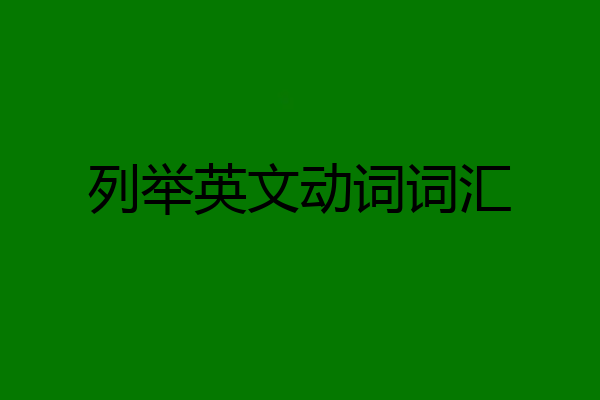 阿蒙宝贝
阿蒙宝贝
共5条回答318浏览
-
 偶是杨洋2小时前发布
偶是杨洋2小时前发布-

动词?!有好多啦~` 英语中的动词主要分为BE动词(即系动词)、实义动词(行为动词)和情态动词。实义动词又分为及物动词和不及物动词。 二者从是否需要宾语来分,实义动词分为及物动词和不及物动词两类。 1)及物动词 后面必须跟宾语意义才完整的实义动词,叫做及物动词(transitive verb)。2)不及物动词 本身意义完整后面不须跟宾语的实义动词,叫做不及物动词(intransitive verb)。如: 3)兼作及物动词和不及物动词 英语里有不少实义动词可以兼作及物动词和不及物动词。这样的动词又有两种不同的情况: a)兼作及物动词和不及物动词时,意义不变。试比较: Shall I begin at once?我可以立刻开始吗?(begin作不及物动词) She began working as a librarian after she left school.她毕业后当图书馆管理员。(began作及物动词) When did they leave Chicago?他们是什么时候离开芝加哥的?(leave 作及物动词) They left last week. 他们是上周离开的。(left 作不及物动词) b)兼作及物动词和不及物动词时,有时意义不尽相同。如: Wash your hands before meals.饭前要洗手。 Does this cloth wash well? 这布经得起洗吗? 4) 与汉语的比较 有时英语动词的及物和不及物的用法,与汉语的用法不一样,请注意下列两种情况: a)有的动词在英语里只能用作不及物动词,而汉语则可用作及物动词,如arrive到达,agree同意,1isten听。英语里这些动词后面常接介词。如: We arrived at the railway station at noon.我们于中午到达火车站。(at不能省去)(比较:We reached the railway station at noon.) Everybody listened to the lecture with great interest.每个人都很有兴趣地听讲课。(to不可省去)(比较:We all heard the lecture.) Do they agree to the plan?他们同意这个计划吗?(to不可省去) b)有的动词在英语里能用作及物动词,而在汉语里则不能用作及物动词,如serve为…服务。 Our children are taught to serve the people wholeheartedly.我们的儿童被教以全心全意为人民服务情态动词:情态动词是一种本身有一定的词义,表示说话人的情绪,态度或语气的动词,但不能单独作谓语, 只能和其他动词原形构成谓语。 情态动词数量不多,但用途广泛,主要有下列: can (could), may (might), must, need, ought to, dare (dared), shall (should), will (would) . 情态动词的位置: 情态动词在句中放在谓语动词之前, 谓语动词前若有助动词,则在助动词之前,疑问句中, 情态动词则在主语之前。 情态动词的特点: 情态动词无人称和数的变化, 情态动词后面跟的动词需用原形,否定式构成是在情态动词后面加 "not"。 个别情态动词有现在式和过去式两种形式, 过去式用来表达更加客气, 委婉的语气, 时态性不强, 可用于过去,现在或将来。BE动词:)是用于构成动词的进行语态和被动语态 2)表示某人某物的存在 3)表示可能会发生的事 4)用于描述某人某物的现有状态 常见的be动词的有am,is,are,WAS、WERE等。(注意:BE动词在情态动词后要变成BE动词原形即BE)
-
-
-
英语动词分为系动词和行为动词,行为动词又分为及物动词和不及物动词。及物动词后面可直接加宾语,不及物动词不能直接加宾语,若要加宾语必须跟介词一起搭配使用。系动词如am is are,及物动词如eat,have,spend等,不及物动词如come,go等。
-
-
 Q糖奶爸7小时前发布
Q糖奶爸7小时前发布-
attract attraction attractive attractivlybelieve belief believable believabllyprotect protection protective protectivelyimpress impresstion impressive impressivelysucceed success successful successfully
-
-
-
系动词:连系动词的种类:连系动词含有一定意义,它们要与其后做表语的形容词,名词或介词(短语)一起构成合成谓语.系动词按意义可分为三类,而且有自己的特定用法.一,按意义连系动词可分为以下几类:1.表示状态的连系动词有: be ; appear ; seem ; keep ; remain ; continue ; stay ; prove 等e.g a . She appears very young . b. His temperature seems to be all right . c. He made a fire in the room to keep warm . d. The weather continued fine . e. This proved very helpful . 2.表示感觉的连系动词有: look ; feel ; smell ; sound ; taste 等e.g a. A paper tiger looks terrible , but in fact it is not . b. The medicine smells terrible . c. Ann felt very happy d. That sounds interesting . 3. 表示转变的连系动词有:become ; fall ; get ; go ; grow ; turn 等a. Beijing is becoming more and more beautiful . b. Soon they fell asleep . c. The trees turn green and the flowers start to come out . 二. 系动词的特点:1. 系动词不用于进行时和被动语态2. 除make 等个别词外,几乎所有的连系动词都能跟形容词作表语,但不能跟副词. 跟名词作表语的有:become ; get ; look ; make ; prove; remain ; seem ; turn ; wear . 等3.我们要特别注意:look ; smell ; taste 等词既可作系动词,也可作实义动词. 作系动词时后跟形容词做表语,作实义动词时则用副词来修饰这些动词. 4. appear , prove , seem 后面可以跟to be + adj , to be 也可省略. Proverb:An apple a day keeps the doctor away . A new broom sweeps clean An eye finds more truth than two ears . An eye for an eye and a tooth for a tooth . A place for everything and everything in its place . He who has never been to the Great Wall isn't a man . In at one ear and out at the other . In every beginning we think of the end . In the end thingswill mend .
-
-
-
attract attraction attractive attractivelycare care careful carefullycheer cheer cheerful cheerfullyuse use useful usefullythank thank thankful thankfullysucceed success successful successfullyspecify specialist special speciallysimplify simple simple simplycreate creation creative creativelymean meaning meaningful meaningfullyimport importance important importantlydiffer difference different differently
-


